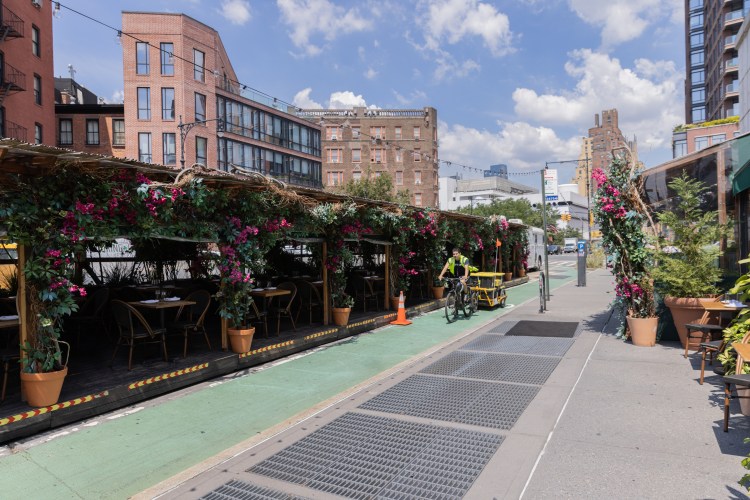
A restaurant’s outdoor dining area in New York City. Most New York restaurants taking part in the city’s pandemic-era outdoor dining program haven’t sought permits to make their sheds permanent, meaning they’ll have to be dismantled. Jeenah Moon/Bloomberg
Most New York City restaurants taking part in the city’s pandemic-era outdoor dining program haven’t sought permits to make their sheds permanent, meaning they’ll have to be dismantled.
About 2,600 dining establishments applied for the permits before the Aug. 3 deadline, according to the city Department of Transportation. That’s less than half of the agency’s estimate of 6,000 to 8,000 restaurants currently using outdoor dining permits issued since 2020.
The deadline for eateries caps months of heated debate among various stakeholders over how or whether to maintain a slice of the vibrant outdoor dining culture that flourished during the pandemic. Critics call the structures eyesores that attract rats and take up parking spaces, while proponents say they inject life into the urban landscape and boost small business operators.
Under the new program, known as Dining Out NYC, roadway sheds must be taken down and stored from the end of November through March, which some restaurants say is cost prohibitive. Operators must also meet certain specifications for the structures, such as not being fully enclosed, which would require some businesses to rebuild them.
The city argues the regulations are needed to maintain safety and order for longer-term fixtures, which weren’t permitted in streets before the pandemic.
Just over 1,300 of the new permit applications are for roadway sheds, while about 2,000 are for sidewalk seating, which will be permitted year-round under less-stringent rules than before the pandemic. Cafes that don’t currently have outdoor seating can still apply at a later date, according to the city. Those who have sheds and haven’t requested new permits will have to take them down.
Manny Colon, owner of the popular Manny’s Bistro on the Upper West Side, signed up for roadway and sidewalk permits, which at $1,050 each for four years is half the price for permits pre-Covid. He estimates a city-approved contractor would charge $40,000 to take down his structure, build a new one to fit specifications and store it all winter.
U-HAUL REQUIRED
Instead, he asked a friend to cut and paint plywood and is planning to U-Haul the shed to his daughter’s house upstate to store it in the winter. Even then, it will cost $25,000, and he’ll have to cut the roadway seating in half to six tables because he said new rules prohibit the length of the shed from being longer than his storefront.
“It’s quite complicated, and that’s why a lot of restaurants are just going to focus on the sidewalk,” he said. But he still expects to turn a profit and is happy the city will rein in street sheds that were “out of control,” such as structures built so that diners stepped out precariously into busy bike lanes.
A spokesman for the city’s restaurant industry said the low number of applicants shows the program needs to be tweaked.
“There are many parts of the new outdoor dining law that are much better than the pre-pandemic sidewalk café law, but despite the Department of Transportation’s outreach and collaboration with restaurants, too small a percentage of eligible small businesses have applied to participate in the Dining Out NYC program,” said Andrew Rigie, executive director of the New York City Hospitality Alliance.
He said the city should analyze why so few restaurants applied to continue the program and make changes to the rules “to help achieve their goal of having the biggest and most inclusive outdoor dining program in the country.”
Related Stories












